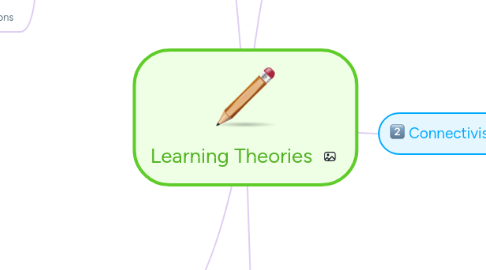
1. Behaviourism
1.1. Principles
1.1.1. learning through practice
1.1.2. Behavior is strengthened through reinforcement
1.1.3. Passive learners Vs direct teacher
1.1.4. Pavlov used classic Conditioning
1.1.4.1. A dog hears a whistle before eating and now associates that sound with food
1.1.5. Instruction is repetition
1.1.6. " Learning should be presented in small manageable blocks." (Kearsley (1994)
1.2. Implications
1.2.1. Focuses on reward and punishment to create a desirable response.
1.2.2. Students are not given the opportunity to learn on their own and create new ideas
1.2.3. Students are considered blank states or empty cups that are to be filled by the teacher who is the sources of knowledge.
1.3. Connections
1.3.1. Drill and practice can be necessary to learn basic skills such as Abc’s/ multiplication.
1.3.2. Can be combined with other teaching method to enhance learning.
1.3.3. Incorporating things such as YouTube videos, BrainPop and Ted talks are all useful behaviorist tools
2. Information Processing (Cognitivism)
2.1. Principles
2.1.1. The mind of a learning is viewed as a computer.
2.1.2. Ideas are stored as recall and are linked with already existing knowledge
2.1.3. Students gain the ability to apply, recall, explain and understand information
2.1.4. The Learning is built off existing schemas
2.1.5. Cognitive load theory
2.2. Implications
2.2.1. Practice is used only for retention.
2.2.2. It is not student center. Some students may have a hard time in connecting newly learned information with previous knowledge.
2.2.3. Uses methods like mapping, Chungking words and brainstorming tools to implement learning
2.3. Connections
2.3.1. Adding new information to previous knowledge could help students adapt to new ideas
2.3.2. Tools such as mind maps, Power points and Glogsters can help reinforce this theory
2.3.2.1. For example, A student can use mind mapping to connect all the concepts learned throughout a course,
3. Connectivism
3.1. Principals
3.1.1. Looks ay learning as a way of developing and creating networks
3.1.1.1. Focusing on where to find information rather having the knowledge
3.1.2. theory of digital age
3.2. Implications
3.2.1. Having access to the most current information
3.2.2. Being able to make connections with your current knowledge is a key skill.
3.3. Connections
3.3.1. (PLN’S) Professional Learning Networks our learning networks where resources are updated and available
3.3.2. Allowing teachers and students to engage and participate by using networks such as Web 2.0.
4. Constructivism
4.1. Principals
4.1.1. Combining previous knowledge with one’s own experiences
4.1.2. Students learn by building connections and interacting with their environment
4.1.3. By starting with a difficult task, students learn basic skills and worked through it.
4.2. Implications
4.2.1. Students learn through discovery
4.2.2. The problem is presented by the teacher and students work through solving it.
4.3. Connections
4.3.1. Blooms Taxonomy
4.3.1.1. Constructivism is an approach that encourages higher order thinking such as analyzing evolving and creating
4.3.2. Mindtools
4.3.2.1. Uses tools such as interactive whiteboards to adapted all types of learning
5. T-Pack
5.1. Principals
5.1.1. TPACK stands for Technology Pedagogy content knowledge. It is a framework and it combines all three principle; technological, pedagogical, and content knowledge
5.1.1.1. Content knowledge
5.1.1.2. pedagogical knowledge
5.1.1.3. Technology knowledge
5.1.1.4. pedagogical content knowledge
5.1.1.5. technological content knowledge
5.1.1.6. Technological pedagogical knowledge
5.1.1.7. Technological pedagogical content knowledge
5.2. Implications
5.2.1. Including technology it Is mandatory according to the ministerial order of Alberta.
5.3. Connections
5.3.1. The entirety of this course has taught us to incorporate Technology within our lessons as future teachers.
5.3.2. Gizmos are a great way to TPACK
